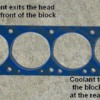Need some help in determining the cause of a serious overheating on my 74 Pantera.
In summary:
Block hot dipped and cleaned prior to machining + 30. Lifter bores sleeved. New forged pistons and rings fitted. New Trickflow fully assembled cylinder heads fitted with recommended Felpro 1013 head gaskets. ARP Head Studs. New Robertshaw thermostat from Marlin with brass plate fitted. New cast iron std water pump. New radiator core. Twin electric puller fans.
Problem: Engine is spewing out the coolant within a minute or two of starting. Engine getting boiling hot while radiator is staying cold. With and without pressure cap.
Several checks for air locks by raising first the rear then the front and venting radiator.
Retorqued heads
Heater inlet and outlet pipes removed at engine. Engine started and no water coming out of either pipe. Thermostat removed and still no water coming out heater pipes.
Heads removed and head gaskets are fitted correctly with front at front.
Water pump brand new and impeller intact. Stock pulley
Thermostat removed. Water put into engine with water pump removed and water flowing out of water outlets at front of the engine. Each of these holes blocked off at different times to check water is flowing through block
Cylinder head gasket and block compression leak test done using test dye. No gas leaks.
No water in oil and no visible cracks in cylinders.
Car not yet been on the road due to these issues.
Been onto Summit as the casting on the heads states SBF 5X and OA2 1207. Never considered the 351C a small block so hopefully the heads are correct. Part No ordered correctly as per 351C TFS 51616204 but not stamped anywhere on heads so can't be sure.
I notice the coolant holes in the Felpro 1013 head gasket are smaller than stock Felpro 351C head gasket, would that make a difference.
Serious water circulation issue I feel but don't know why. Anyone got any clues.
Cheers
Original Post


